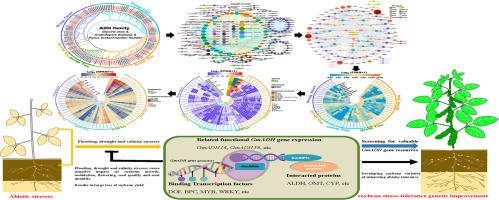大豆Glycine max (L.)醇脱氢酶家族成员的全基因组鉴定、进化解析及表达谱分析稳定)。
IF 6.8
Q1 PLANT SCIENCES
引用次数: 0
摘要
乙醇脱氢酶(ADH)蛋白是植物发育和参与各种胁迫反应所必需的。大豆(Glycine max (L.))的全基因组鉴定、进化历史和表达特征稳定)。ADH基因仍然滞后。在这项研究中,我们从Wm82.a2中鉴定出58个Glycine max ADH (GmADH)基因。大豆V1基因组分为4个支系,分布在19条染色体上。同一分支的GmADH成员在基因结构、基序模式和蛋白质结构上具有相似性。蛋白质-蛋白质相互作用(PPI)分析表明,GmADHs可能参与不同的生物过程。片段重复被发现是产生新的GmADH基因的主要力量。Syntenic和进化研究证明,GmADH基因在进化过程中经历了强烈的纯化选择。通过启动子区顺式元件和推测结合转录因子(TFs)的筛选以及表达谱分析,揭示了GmADH基因在大豆发育、洪涝、干旱和盐胁迫中的不同调控作用。本研究为今后基因功能研究提供了有价值的见解,可促进有利的GmADH基因资源在大豆遗传改良中的应用。本文章由计算机程序翻译,如有差异,请以英文原文为准。

Whole-genome identification, evolutionary decipherment, and expression profiling analyses of alcohol dehydrogenase family members in soybean (Glycine max (L.) Merr.)
Alcohol dehydrogenase (ADH) proteins are essential to plant development and participate in various stress responses. However, whole-genome identification, evolutionary history and expression characteristics of soybean (Glycine max (L.) Merr.) ADH genes remain lagging. In this study, we identified 58 Glycine max ADH (GmADH) genes from the Wm82.a2.v1 soybean genome, which were classified into four clades and unevenly distributed on 19 chromosomes. GmADH members in the same clades showed analogies in gene structures, motif patterns and protein structures. Protein-protein interaction (PPI) analyses demonstrated that GmADHs might be involved in distinct biological processes. The segmental duplications were found to be the major force in deriving new GmADH genes. Syntenic and evolutionary investigations proved that the GmADH genes underwent strong purifying selections during evolution. The screening of cis-elements and putative binding transcription factors (TFs) in promoter regions as well as the expression profiling explorations revealed the different regulatory roles of GmADH genes during soybean development, flooding, drought and salt stresses. This work provides valuable insights for future gene functional research, which may boost the applications of favorable GmADH gene resources in soybean genetic improvement.
求助全文
通过发布文献求助,成功后即可免费获取论文全文。
去求助
来源期刊

Plant Stress
PLANT SCIENCES-
CiteScore
5.20
自引率
8.00%
发文量
76
审稿时长
63 days
期刊介绍:
The journal Plant Stress deals with plant (or other photoautotrophs, such as algae, cyanobacteria and lichens) responses to abiotic and biotic stress factors that can result in limited growth and productivity. Such responses can be analyzed and described at a physiological, biochemical and molecular level. Experimental approaches/technologies aiming to improve growth and productivity with a potential for downstream validation under stress conditions will also be considered. Both fundamental and applied research manuscripts are welcome, provided that clear mechanistic hypotheses are made and descriptive approaches are avoided. In addition, high-quality review articles will also be considered, provided they follow a critical approach and stimulate thought for future research avenues.
Plant Stress welcomes high-quality manuscripts related (but not limited) to interactions between plants and:
Lack of water (drought) and excess (flooding),
Salinity stress,
Elevated temperature and/or low temperature (chilling and freezing),
Hypoxia and/or anoxia,
Mineral nutrient excess and/or deficiency,
Heavy metals and/or metalloids,
Plant priming (chemical, biological, physiological, nanomaterial, biostimulant) approaches for improved stress protection,
Viral, phytoplasma, bacterial and fungal plant-pathogen interactions.
The journal welcomes basic and applied research articles, as well as review articles and short communications. All submitted manuscripts will be subject to a thorough peer-reviewing process.
 求助内容:
求助内容: 应助结果提醒方式:
应助结果提醒方式:


